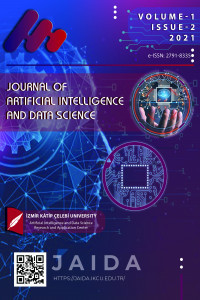A Novel, Nelder-Mead Optimization Approach, based on Neuro-regression modeling for the Energy Efficiency Parameters of End Milling Process
A Novel, Nelder-Mead Optimization Approach, based on Neuro-regression modeling for the Energy Efficiency Parameters of End Milling Process
End milling, energy efficiency optimization,
___
- [1] P. Albertellia, A. Kesharia, and A. Matta, “Energy oriented multi cutting parameter optimization in face milling.” Journal of Cleaner Production, vol.137, pp. 1602-1618, 2016
- [2] L. Zhoua, J. Lia, F. Lia, G. Mendisb, and J. W. Sutherlandb, “Optimization parameters for energy efficiency in end milling,” PROCEDIA CIRP, vol. 69, pp. 312-317, Copenhagen, Denmark, 2018.
- [3] R. Kumar, P. S. Bilga, and S. Singh, "Multi-objective optimization using different methods of assigning weights to energy consumption responses, surface roughness and material removal rate during rough turning operation,” Journal of Cleaner Production, vol.164, pp.45-57, 2017
- [4] B. A. Khidhir, and B. Mohamed, "Analyzing the effect of cutting parameters on surface roughness and tool wear when machining nickel-based Hastelloy – 276." Materials Science and Engineering Conference Series,vol.17, pp. 012043, 2011.
- [5] J. Ribeiro, H. Lopes, L. Queijo, and D. Figueiredo, "Optimization of cutting parameters to minimize the surface roughness in the end milling process using the Taguchi method." Periodica Polytechnica. Engineering. Mechanical Engineering; Budapest, vol. 61, pp. 30-35, 2017.
- [6] S. Velchev, I. Kolev, K. Ivanov, and S. Gechevski, “Empirical models for specific energy consumption and optimization of cutting parameters for minimizing energy consumption during turning,” J. Clean. Prod, vol. 80, pp. 139-149, 2014.
- [7] C. C. Negrete, "Optimization of cutting parameters for minimizing energy consumption in turning of AISI 6061 T6 using Taguchi methodology and ANOVA," Journal of Cleaner Production, vol. 53, pp.195-203, 2013.
- [8] P. T. Mativenga, and M. F. Rajemi, “Calculation of optimum cutting parameters based on minimum energy footprint,” CIRP Ann Manuf Technol, vol. 60, pp. 149-152, 2011.
- [9] M. F. Rajemi, P. T. Mativenga, and A. Aramcharoen, “Sustainable machining : selection of optimum turning conditions based on minimum energy considerations,” J Clean Prod, vol. 18, pp, 1059-1065, 2010.
- [10] I. Asilturk, S. Neseli, and M.A. Ince, "Optimisation of parameters affecting surface roughness of Co28Cr6Mo medical material during CNC lathe machining by using the Taguchi and RSM methods," Measurement, vol. 78, pp. 120-128, 2016.
- [11] R. K. Bhushan, “Optimization of cutting parameters for minimizing power consumption and maximizing tool life during machining of Al alloy SiC particle composites,” Journal of Cleaner Production, vol. 39, pp. 242-254, 2013.
- [12] C. Li, Q. Xiao, Y. Tang, and L. Li, “A method integrating Taguchi, RSM and MOPSO to CNC machining parameters optimization for energy saving,” J. Clean. Prod., vol. 135, pp. 263-275, 2016.
- [13] A. J. Kulkarni, K. Tai, and A. Abraham, “Probability collectives: a distributed multi-agent system approach for optimization,” In: Intelligent Systems Reference Library, pp. 86, 2015.
- [14] I. Polatoğlu, L. Aydın, B.C. Nevruz and S. Ozer, “A Novel Approach for the Optimal Design of a Biosensor”. Analytical Letters, pp.1-18, 2020.
- [15] I. Polatoglu, and L. Aydin, “A new design strategy with stochastic optimization on the preparation of magnetite cross-linked tyrosinase aggregates (MCLTA),” Process Biochemistry, vol. 99, pp. 131–138, 2020.
- Yayın Aralığı: Yılda 2 Sayı
- Başlangıç: 2021
- Yayıncı: İzmir Katip Çelebi Üniversitesi
Fabric Defect Classification Using Combination of Deep Learning and Machine Learning
Fatma Günseli YAŞAR ÇIKLAÇANDIR, Semih UTKU, Hakan ÖZDEMİR
Identification of Breast Cancer Metastasis Using Boosting Algorithms on Cytopathologic Data
Modeling and optimum design for wire electrical discharge machining of γ titanium aluminide alloy
A Face Authentication System Using Landmark Detection
Serap TANRIVERDİ, Levent AYDIN
Özlem AKTAŞ, Berkay COŞKUNER, İlker SONER
Turkish Character Usage in Text Classification
Modeling and Design Optimization to Determine the Mechanical Properties of a Recent Composite
